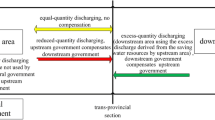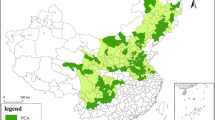Abstract
Eco-compensation is a multi-disciplinary topic. There is no consensus on the issue of river eco-compensation across districts. Although policies regarding river eco-compensation have been issued in China since 2008, due to the high cost, eco-compensation has not been well implemented in the Taihu pilot region. Therefore, a simplified method based solely on water quality (both water quality and water volume included in the Taihu method) was proposed for North Jiangsu province (NJP). However, the formula was flawed and it led to payments being too low. Three problems need to be solved: (1) how to specify the eco-compensation areas; (2) how to test a reasonable eco-compensation model and (3) how to determine the compensation criterion. Solving these issues is already a priority. In this paper, three potential solutions surrounding eco-compensation are discussed: (1) three principles for selecting the representative eco-compensation areas are suggested; (2) the compensation calculation method based on contaminant flux above the ultra standard is revised and (3) a compensation criterion model based on the treatment costs of sewage is proposed. In the NJP case in 2009, the average eco-compensation criterion for chemical oxygen demand (COD) is 2,000 Chinese Yuan (CNY) per ton and ammonia nitrogen (NH4–N) and total phosphorus (TP) are 8,000 CNY and 80,000 CNY per ton, respectively. Five districts needed to be compensated. The payments in the revised scheme were 4.15–586 million CNY, which were 16–48 times greater than that in the draft method. The new method can provide an important template for managers when drafting river eco-compensation schemes.

Similar content being viewed by others
References
Albrecht M, Schmid B, Obrist MK, Schupbach B, Kleijn D, Duelli P (2010) Effects of ecological compensation meadows on arthropod diversity in adjacent intensively managed grassland. Biol Conserv 143:642–649
Aschwanden J, Birrer S, Jenni L (2005) Are ecological compensation areas attractive hunting sites for common kestrels (Falco tinnunculus) and long-eared owls (Asio otus)? J Ornithol 146:279–286
Aschwanden J, Holzgang O, Jenni L (2007) Important of ecological compensation areas for small mammals in intensively farmed areas. Wildl Biol 13:150–158
Cuperus R, Canters KJ, Udo de haes HA, Friedman DS (1999) Guidelines for ecological compensation associated with highways. Biol Conserv 90:41–51
Cuperus R, Kalsbeek M, Udo de haes HA, Canters KJ (2002) Preparation and implementation of seven ecological compensation plans for Dutch highways. Environ Manag 29:736–749
Environmental Protection Department of Jiangsu province [Jiangsu EPD] (2007) Environmental resources compensation in pilot region of Taihu watershed in Jiangsu province, China. (in Chinese)
GB18918-2002 (2002) Discharge standard of pollutants for municipal wastewater treatment plant. Standard Press of China, Beijing
GB3838-2002 (2002) Environmental quality standards for surface water. Standard Press of China, Beijing
Jiangsu Statistics Bureau [JSB] (2009) Statistical yearbook of Jiangsu. China Statistics Press, Beijing (in Chinese)
Jiao J (2008) The main pollution sources of Jiangsu province countryside of nitrogen and phosphorus pollution load of regional assessment and control countermeasures. Dissertation, Nanjing Agricultural University (in Chinese)
Johst K, Drechsler M, Watzold F (2002) An ecological-economic modelling procedure to design compensation payments for the efficient spatio-temporal allocation of species protection measures. Ecol Econ 41:37–49
King J, Brown C, Sabet H (2003) A scenario-based holistic approach to environmental flow assessments for rivers. River Res Appl 19:619–639
Mao F, Zeng X (2006) The mechanisms and principles of ecological compensation. Ecol Sin 26:3841–3846 (in Chinese)
Pang AP, Li CH, Liu KK, Shen N (2010) Ecological compensation in the water source areas of Zhangweinan basin based on water environmental capacity. China Popul Resour Environ 20:100–103 (in Chinese)
Peng XC, Liu Q, Zhou LX, Zheng SY, Guo M, Zhang XX (2010) Study of ecological compensation mechanism of Dongjiang river based on contingent valuation method. Ecol Environ Sci 19:1605–1610 (in Chinese)
Qi R (2009) A water footprint based model on river basin eco-compensation. Dissertation, Dalian University of Technology (in Chinese)
Rosegrant MW, Binswanger HP (1994) Markets in tradable water rights: potential for efficiency gains in developing country water resource allocation. World Dev 22:1613–1625
Shen YF, Cai QH (2003) Complexity in freshwater ecosystems. J Grad Sch Chin Acad Sci 20:131–138 (in Chinese)
Tian PP (2006) Study on regional ecological security and compensation based on the analysis of ecological footprint in Guanzhong region. Dissertation, Northwest University (in Chinese)
van Bohemen HD (1998) Habitat fragmentation, infrastructure and ecological engineering. Ecol Eng 11:199–207
Wang FN (2006) About the mechanism and principle of ecological compensation. Stud Dialect Nat 22:31–35 (in Chinese)
Water Resources Department of Jiangsu Province [Jiangsu WBD] (2009) Surface water environmental function areas adjustment programs for North Liutang River. IOP Publishing PhysicsWeb. http://www.lygwater.gov.cn/xx.aspx?id=2417. Accessed 26 Apr 2010 (in Chinese)
Williams YM, Williams SE, Alford RA, Waycott M, Johnson CN (2006) Niche breadth and geographical range: ecological compensation for geographical rarity in rainforest frogs. Biol Lett 2:532–535
Xiong Y, Wang KL (2010) Eco-compensation effects of the wetland recovery in Dongting lake area. J Geogr Sci 20:389–405
Xu DW, Zheng HX, Liu MQ (2008) Measuring method of river basin ecological compensation based on river water quality and its water quantity about across administration area. China Popul Resour Environ 18:189–194 (in Chinese)
Xu CY, Qian ZM, Li YR, Peng BR (2009) Modeling environmental responsibility definition in ecological compensation of watershed. J Nat Resour 24:1488–1496 (in Chinese)
Zhang CQ (1987) Paid use of renewable resources. Res Agric Mod 5:22–24 (in Chinese)
Zhang L (2009) Study on watershed ecological compensation standards and ecological compensation mechanism—A case study on the Pishihang basin. Dissertation, Hefei University of Technology (in Chinese)
Zhang LM, Wang S, Han M, He Q, Pan GQ, Wang C (2010) Nitrogen and phosphorus pollution in the western district of Wangyu River and counter measures, Taihu Basin. J Lake Sci 22:315–320 (in Chinese)
Zheng Y, Zhang TZ (2000) Emission trade in USA from theory to practice. Shanghai Environ Sci 11:505–507 (in Chinese)
Zhong DS, Zhang HW (2005) Equal standard pollution load method for evaluating the effect of pollution source on aquatic environment. China Water Waste Water 21:101–103 (in Chinese)
Zhou W, Wang GX, Liu JE, Mao ZG (2009) Assessment and analysis of water quality of main estuaries in Jiangsu province. Water Resour Prot 25:16–19 (in Chinese)
Acknowledgments
This research has been financially supported by Environmental Protection Department of Jiangsu province, the data was supported by Jiangsu Provincial Environmental Monitoring Center. We are grateful to Prof. Yiping Li, Desmond Ofosu Anim and journal experts for valuable comments on this paper.
Author information
Authors and Affiliations
Corresponding author
Rights and permissions
About this article
Cite this article
Xie, R., Pang, Y., Li, Z. et al. Eco-Compensation in Multi-District River Networks in North Jiangsu, China. Environmental Management 51, 874–881 (2013). https://doi.org/10.1007/s00267-012-9992-5
Received:
Accepted:
Published:
Issue Date:
DOI: https://doi.org/10.1007/s00267-012-9992-5




